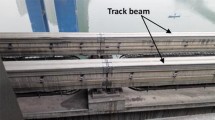Abstract
Crosswind is the primary external excitation source of the straddle monorail system. To ensure the ride quality of the monorail system under crosswind, based on multi-rigid body dynamics and finite element method, the coupling model of the monorail vehicle-beam is established, in which the track beam is considered as a flexible sub-model; the vehicle includes traveling/steering/stabilizing wheels and evaluate the characteristics of tire sideways and slip. Crosswind was obtained by the Davenport spectrum and loaded on the vehicle. Dynamic responses of the vehicle-beam system and the safe running/wind speed were studied. The study shows that, for a car, the wind loaded outside balances part of the centrifugal action and eliminates part of the overturning trend of the vehicle when it turns but makes the lateral ride comfort deteriorate in the straight line section. For the beam, the wind loads help reduce the track beam's transverse deformation when cars pass, and the vertical deformation is slightly improved. For operation, when the running speed is less than 50 km/h and the wind speed is less than 15 m/s, the monorail vehicle can operate safely. The straddle monorail wind-vehicle-beam model can conveniently update the design parameters for dynamic calculation and comfort evaluation. It can provide a specific theoretical basis or guiding principles for the safe operation of straddle monorail vehicles under wind loads.
Similar content being viewed by others
References
C. H. Lee, C. W. Kim and M. Kawatani, Dynamic response analysis of monorail bridges under moving trains and riding comfort of trains, Engineering Structures, 27 (2005) 1999–2013.
Y. L. Bao, W. M. Zhai and C. B. Cai, Dynamic interaction analysis of suspended monorail vehicle and bridge subject to crosswinds, Mechanical Systems and Signal Processing, 156 (2021) 107707.
Y. L. Bao, W. M. Zhai and C. B. Cai, Effect of the combined center of gravity height on suspended monorail train ride comfort under crosswinds, Vehicle System Dynamics, 61(8) (2022) 1954–1972.
Y. L. Bao, W. M. Zhai and B. Cai, Impact coefficient analysis of track beams due to moving suspended monorail vehicles, Vehicle System Dynamics, 60(2) (2020) 653–669.
Y. F. Zhang and L. Li, Crosswind stability of metro train on a high-pier viaduct under spatial gust environment in mountain city, KSCE Journal of Civil Engineering, 25(12) (2021) 4661–4670.
Y. F. Zhang and L. Li, Spatial gust impact analysis on safety and comfort of a train crossing cable-stayed bridge combining statistical method, Journal of Central South University, 29 (2021) 2605–2620.
Y. F. Zhang, J. Li and Z. W. Chen, Dynamic analysis of metro vehicle traveling on a high-pier viaduct under crosswind in Chongqing, Wind and Structures, 29(5) (2019) 299–312.
Y. F. Zhang, J. Li and Z. W. Chen, Running safety of metro train over a high pier bridge subjected to fluctuating crosswind in mountain city, Structural Engineering and Mechanics, 76(2) (2020) 205–220.
J. Li, R. Wei and H. B. Wei, Stability analysis of straddle monorail vehicle under crosswind disturbance, Journal of Huaqiao University (Natural Science), 41(3) (2020) 285–291 (in Chinese).
K. Suh and H. Yoon, Numerical investigations of the cross-wind stability of the Korean light tactical vehicle during airlift, Journal of Mechanical Science and Technology, 31(3) (2017) 1067–1072.
Y. F. Zou, Z. P. Liu and K. Shi, Experimental study of the aerodynamic characteristics of a suspended monorail vehicle-bridge system under crosswinds, International Journal of Structural Stability and Dynamics, 22(10) (2022) 2241007.
BS EN 14067-6, Railway Applications - Aerodynamics-Part 6: Requirements and Test Procedures for Crosswind Assessment, British Standards Institution, London, British (2018).
C. S. Cai, J. X. Hu and S. Chen, A coupled wind-vehicle-bridge system and its applications: a review, Wind and Structures, 20(2) (2015) 117–142.
Acknowledgments
The research described in this paper was financially supported by the Science and Technology Research Project of Henan Provincial Science and Technology Department (232102241008), the Key Teacher Training Funding Project of Zhengzhou Railway Vocational and Technical College (3215210001).
Author information
Authors and Affiliations
Corresponding author
Additional information
Zhifang Ma is a lecturer at the School of Railway Engineering, Zhengzhou Railway Vocational and Technical College. Her research field mainly covers the vibration of vehicle-bridge systems and bridge engineering.
Yunhong Guo is an Associate Professor at the School of Railway Engineering, Zhengzhou Railway Vocational and Technical College. His research interests include computer application technology, project management, and engineering applications.
Rights and permissions
About this article
Cite this article
Ma, Z., Guo, Y. Crosswind impacts on comfort of straddle monorail vehicle running on flexible track beam. J Mech Sci Technol 38, 569–577 (2024). https://doi.org/10.1007/s12206-024-0106-0
Received:
Revised:
Accepted:
Published:
Issue Date:
DOI: https://doi.org/10.1007/s12206-024-0106-0




